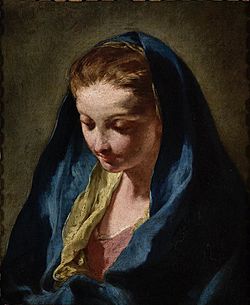Head of the Virgin (Pittoni) facts for kids
Quick facts for kids Head of the Virgin |
|
|---|---|
| Italian: La Testa della Vergine, French: La Tête de Vierge | |
 |
|
| Artist | Giambattista Pittoni |
| Year | c. 1730 |
| Type | Oil on poplar |
| Dimensions | 110 cm × 89 cm (44 in × 35 in) |
| Location | Musée des Beaux-Arts de Strasbourg, Strasbourg |
The Head of the Virgin is a beautiful painting from the 1700s. It is also known by its French name, La Tête de Vierge, or its Italian name, La Testa della Vergine. This artwork was created around 1730 by a famous artist named Giambattista Pittoni.
Pittoni painted it using oil paint on a poplar wood panel. He made it during the Rococo period in Venice, Italy. Today, you can see this special painting at the Musée des Beaux-Arts de Strasbourg in France. Many people find the Virgin's eyes in the painting quite mysterious. At the time, it was unusual for a portrait to show a low gaze like this.
What Makes This Painting Special?
Pittoni's paintings often have a unique look. He used a "remote pictorial touch," which means his brushstrokes might seem soft or a bit blurry from up close. He also used a "delicate palette," meaning he chose soft, gentle colors. These are classic signs of Pittoni's style.
This painting is actually a small part of a much bigger artwork. The larger painting is called «The Nativity with God the Father and the Holy Spirit». You can find this bigger painting at the National Gallery in London.

Artists sometimes create smaller versions of their work. The Head of the Virgin might have been made for a few reasons. It could have been a separate piece created by Pittoni to sell. Or, it might have been a "preparatory sketch." This is like a practice drawing or painting an artist makes before starting a large, important work. For example, there's a similar painting in Berlin that might have been a sketch for an altarpiece (a large artwork placed behind an altar in a church).

